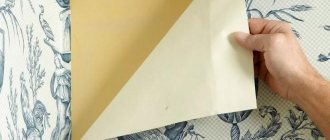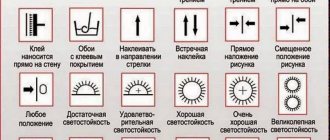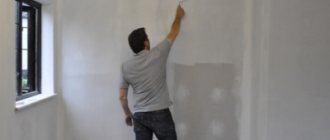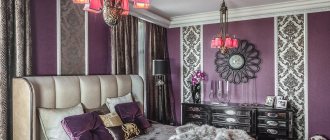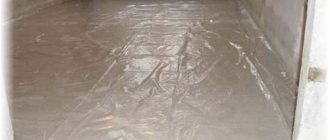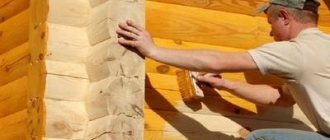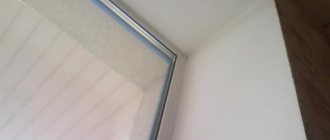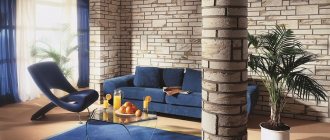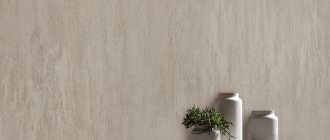It would seem that what could be difficult about wallpapering? We cut, spread and glue, that's all. But with this approach, you can easily ruin the material you have been choosing for so long or get a completely different result than was planned. It turns out that the process of gluing with your own hands has many subtleties, especially when it comes to wallpaper with a pronounced pattern. Before starting work, you will have to find out what rapport is, how to cut the wallpaper so that the image on adjacent strips matches, and finally, how to properly glue wallpaper with a pattern.
Types of patterns on wallpaper and features of its combination
Images on canvases can be divided into several types, which will differ not only in appearance, but also in the principle of working with them.
- Monochrome pattern. This includes canvases without any image or pronounced pattern, for example, speckled, polka dotted, or with texture. It does not require joining of image elements, which means it will be easier to work with such canvases.
- Abstract – broad strokes, stains, spots, often arranged in a chaotic manner. Such wallpaper usually does not require adjustment of the stripes.
- Geometric – lines, squares, circles, diamonds, small and large. Most likely, a combination of elements will be required.
- Strip. Vertical usually does not require adjustment; horizontal requires precise alignment.
- Vegetable – leaves, stems, branches, flowers. As a rule, the pattern elements need to be adjusted.
- Classic - monograms intertwined with each other and forming a single whole on the surface of the wall. Docking is required.
- Ornamental - hieroglyphs, ornaments, motifs of Persian carpets, etc. The need for adjustment depends on the nature of the design.
Plain wallpaper
Abstraction
Geometric pattern
Strip
Floral drawing
Ornament
Monograms
Cross cutting wallpaper
At first glance, the whole cutting process is incredibly simple - measure the distance in height, mark it and cut off a piece of wallpaper. But it was not there! If the first cut is made crooked, then the remaining cuts will be crooked!
Note!
In addition to the length of the blade, it is very important to observe the cutting angle. The ideal angle is 90°, otherwise there will be great difficulties when wallpapering.
In view of this, a protractor is needed to cut the canvas. It does not necessarily have to be a school protractor. Here you can get by with any object that has an angle of 90°. For example, this could be a CD case. Alternatively, you can use a drawing square. Each time you should align the edge of the blade with the edge of the workpiece. This way you will have 2 angles, each 90°.
What is rapport
Rapport (pattern step) is the repetition of an image on one strip of wallpaper. Information about it is usually contained on the roll label.
There are two types of rapport:
- in height – repeating the pattern along the entire length of the wallpaper sheet;
- side – duplicating the pattern along the width of the strip.
The first type of repeat (the height of the repeating pattern) will be involved in the calculations, which is why it is mentioned below.
Knowing the ratio of the height of the repeat and the height of the room, you can easily calculate how much will have to be cut from each strip so that the pattern matches.
Ways to work with multiple rolls simultaneously
To reduce consumption, it is easier to cut webs from several rolls at once . To do this, 3-4 packages are opened and the main fabric is measured from the first. Subsequent calculations should consist of choosing the roll whose pattern diverges least from the first strip.
It should be borne in mind that it is easier to carry out these operations by subtracting the portion of the report that should be cut off. If it is 0.5 of the width of the element, two rolls will be enough; if it is approximately 1/3 of the pattern pitch, you will need to cut 3 rolls one by one. If 0.25 from the report, then 4 rolls will give the lowest consumption. In this case, it is best to substitute the previous canvases for each of them. This way you can avoid mistakes and take measurements as accurately as possible.
Fitting a pattern from several rolls saves up to 25% of the required material.
Features of gluing wallpaper with a pattern
Working with printed wallpaper has its own nuances. Knowing these features will help you avoid mistakes, such as pattern inconsistencies.
- When purchasing material, it is taken into account that the amount of waste will increase due to the need to combine the pattern. Therefore, you need to take rolls with a reserve. Knowing the repeat pitch, you can calculate the required number of tubes most accurately.
Advice. To significantly reduce the share of waste, it is recommended to cut pieces from different rolls when selecting a pattern.
- For perfect alignment of the image, be sure to leave allowances of several centimeters at both ends of the strip.
- During gluing, special attention is paid to the joints.
USEFUL INFORMATION: Decorative PVC panels: great opportunities with minimal costs
Using leftovers, combining wallpaper
The scraps can be glued in places that cannot be seen - behind a closet, sofa, radiator, under a window covered with a curtain. This way you can save a roll of finishing material. You should also leave at least 1 m of waste in case of repairs.
Combining different colors and even wallpaper materials will help not only to avoid unnecessary trimmings. At the same time, it is not difficult to create a stylish and original interior of the room. To do this, you need to familiarize yourself with the rules of combination, select wallpaper and paste it.
To buy the right amount of wallpaper and adjust the pattern with little waste, carefully measure the room that will be finished. Next, the required number of rolls is calculated several times, taking into account possible savings. For control, it is appropriate to ask the sales consultant to perform a recalculation. In this case, there will be no unnecessary waste and expenses.
Calculation of wallpaper without adjusting the pattern
Some canvases, for example, vertical stripes or specks, do not require adjusting the picture.
Let's consider the calculation procedure using the example of a room with the following parameters: perimeter - 18 m, ceiling height - 2.5 m. Standard roll width - 53 cm, length - 10 m.
- We divide the perimeter of the room by the width of the wallpaper tube and get the number of stripes. We round the result up (18: 0.53 = 34 with rounding).
- Divide the length of the canvas by the height of the room (10: 2.5 = 4 stripes). Possible displacement of the cuts will be hidden by skirting boards near the floor and ceiling.
- To obtain the required number of rolls, divide the first result by the second (34: 4 = 8.5). Round up, we get 9 tubes.
Attention! In the case of gluing wallpaper with an overlapping image, the resulting width of the material should decrease by two to three centimeters.
Fitting of canvases
Let's look at how to adjust canvases to match the design for minimal consumption. The fitting process consists of the following steps :
- The canvases are cut from several rolls.
- Reducing the workpiece length.
- Cutting strips according to the image with an insignificant offset.
- Using scraps.
To reduce costs, it is best to use all these methods at once, if the pattern and type of wallpaper allows it.
No waste
If you install ceiling cornices or baguettes, skirting boards by about 10-15 cm, you can save on the length of each panel. This is done when the discrepancy in the fitting pattern falls within this interval. Otherwise, it will be very difficult to fill in the missing parts of the canvas .
You need to remember that you need a few centimeters of margin for these finishing elements so that no discrepancies or gaps are created. Savings should be reasonable, without excessive greed, so as not to spoil the material altogether.
If you have patterns with curls or waves that are very similar in shape and structure, you can use the method of slightly shifting the pattern. Then such a discrepancy will not be noticeable. The main adjustment is done on the walls, where the pattern fits together as accurately as possible .
Discrepancies are left for corners, niches and areas near window and door openings. This will create a symmetrical pattern on opposite walls.
If, as a result of cutting the main continuous sheets 2.5 m long, small parts up to 1.5 m remain, then they can also be used. You should not glue such strips horizontally , as these seams will be very noticeable. It is best to fill the space above and below windows and above doorways with scraps. This allows you to save approximately 10-20% of the required material, i.e. 1 roll for 6-7 required.
In internal and external corners
It is most difficult to adjust the pattern for the outer and outer corners . At such transitions in the geometry of the room, distortion is least noticeable. But it is important not to overdo it and not make such differences too noticeable, so as not to spoil the overall picture of the background.
Following these rules will help you avoid shortcomings and mistakes:
- The joints located at the outer and outer corners should not be touched.
- The easiest way to mask inconsistencies is at the top of the corner.
- The edges of each strip in these areas must be glued according to the markings made in advance. You need to trim the second sheet along the edges.
Calculation with drawing adjustment
Wallpaper with complex or large patterns requires adjustment, so the calculation will be different. The length of the strip must exceed the height of the room and be a multiple of the repeat (pattern step).
Let's analyze the calculation procedure for the same room (perimeter - 18 m, ceiling height - 2.5 m). Roll width – 53 cm, length – 10 m, repeat – 38 cm.
- The strip length is calculated as follows. Divide the height of the room by the rapport value (2.5: 0.38 = 6.6). Round the resulting number up to the nearest whole number. In our case it will be 7. We multiply the image pitch value by the resulting number (0.38 × 7 = 2.66 m). Now we divide the length of the roll by the existing result (10: 2.66 = 3.8). Round to the nearest whole number, but downwards. It turns out that the roll is enough for 3 cuts, the rest is forced losses.
- Next, we calculate the number of tubes. First, we find the number of strips; to do this, we divide the perimeter by the width of the roll, as in the first case (18: 0.53 = 34, rounded). Now we divide the resulting value by the number of stripes in the tube (34: 3 = 12, rounded). Our room will require 12 rolls.
USEFUL INFORMATION: Wall decoration in the kitchen: options
As you can see, the difference between the number of wallpapers with a pattern without matching and an image that requires adjustment is as much as 3 tubes.
We combine
Quite often in construction stores, and even in markets, you can find promotions and discounts on certain wallpapers. Thus, if you harmoniously select another roll by color, texture and similar pattern, then the room can be covered with two types of wallpaper.
The end result will look very impressive and beautiful, will please your eyes and surprise your new and old friends every time they come to visit you.
However, in reality everything is not so simple and combining wallpaper correctly is not so simple. First of all, you need to adhere to the most important rule, namely, maintain the same distance between the elements of the drawings that are repeated.
That's the whole point. That the less distance you use, the more costs and the amount of wallpaper you will spend on the wall.
Don’t forget that the design will need to be adjusted, and otherwise you will be left with a large number of small, cut pieces that you probably won’t be able to use in the future and will most likely simply throw in the trash. But this is all money!
AllaAuthor of the article
Did you like the article?
Share with your friends:
Preparing the wall surface
Preliminary work before gluing wallpaper with a pattern does not differ from standard preparation. The algorithm looks like this:
- Clean the surface from old coatings. How to do it correctly, read here.
- Apply a coat of primer.
- Putty the surface (if there are chips, cracks, or uneven surfaces).
- Let the walls dry.
- Clean with sandpaper or sanding mesh.
- Prime again.
How to prepare drywall for wallpapering is written in detail here.
Marking the wall and placing a large picture
Often when gluing wallpaper you have to deal with walls and ceilings that have a slope. The marking method will depend on the degree of curvature of the corners. First you need to measure the height of the room in each of them.
- If there is a slight slope, you need to use a plumb line or a laser level to mark the walls in order to maintain a strict vertical line.
- If the difference is more than 6–8 cm, it is recommended to stick the wallpaper with a pattern perpendicular to the ceiling, without focusing on a plumb line. In such a situation, stripes that are perfectly aligned vertically will appear overwhelmed due to the visual effect created by the sloping surface.
Important! Wallpaper with vertical stripes is glued strictly plumb, regardless of the degree of curvature of the ceiling surface.
- If the ceiling is uneven, wallpaper with a large pattern should be glued in such a way that for the first time the volumetric element of the image is located as far as possible from the top of the wall. Otherwise, the curvature of the surface will be immediately noticeable.
Even with correctly done markings, the pattern of the last strip may not coincide with the first due to the curvature of the surfaces. Therefore, when deciding where to start gluing material with a pronounced image, it is better to choose the most inconspicuous place in the room.
How to cut an edge correctly
Thin wallpaper is glued overlapping. This means that the edge should be cut on one side. Scissors or a construction knife can be used for this. Thick wallpaper is glued end to end. In this case, the edge is cut on both sides. It is important to do this carefully, using a knife and a ruler (construction spirit level).
After cutting, the finished canvases are laid on a flat, dry surface free of dust and dirt. Now you need to inspect the edges of the wallpaper for possible defects that may form if the edges are removed incorrectly. Now you can start cutting the wallpaper.
Drawing without offset
When gluing wallpaper, the image on which does not need to be shifted, proceed as follows:
- Using the calculations made, we cut the roll into strips, the length of which is a multiple of the repeat step and slightly exceeds the height of the room.
- Wallpaper with a large pattern must be pasted taking into account rapport. All stripes must start with the same pattern; to do this, you need to select canvases so that the pattern matches. If you use strips from the second roll to combine, there will be much less scraps.
- Thin wallpaper is glued with an overlap. You need to start work from a wall close to the window, otherwise overlaps will be noticeable.
- The first strip should be placed from the drawn vertical line near the corner (plumb line).
- After the opposite wall is pasted to the corner, we return to the first vertical line, which served as our starting point, and continue to glue wallpaper from it.
USEFUL INFORMATION: Vinyl wallpaper on non-woven backing: technology for working with the material
Pasting and trimming wallpaper on outer corners
External corners are also found in rooms. These could be door/window slopes. If you have to wallpaper smooth slopes, then everything is simple. So, stick the wallpaper on one side so that the edge of the sheet overlaps the adjacent wall by about 4 cm. Align and smooth the sheet of wallpaper. If folds and bubbles appear, make several small horizontal cuts on the wallpaper sheet.
Next, trim the folded edge of the sheet so that a small edge remains. Measure the next sheet to work with and glue it to the slope. So, you will get a slight overlap. If you are covering vinyl wallpaper, you should use special glue in the overlapping areas.
Pasting external corners
We hope that the information we provided was useful to you. If you have any questions while reading the material, you can ask our expert. Would you like to comment on what you read? In this case, write to us. You can leave comments at the end of the article.
Offset pattern
It happens that the image elements in all the stripes at the edges do not match in height and therefore the wallpaper is glued with the pattern offset. If you take adjacent strips from the same roll, you will end up with a huge overrun. Let's use a trick that will help save material.
We take 2 tubes and unwind them on the floor. We combine the canvas from the 2nd roll with the strip from the 1st. We lay out the cut sheets in two piles. Then the pattern on the wallpaper from the two rolls will match. When gluing, stripes from both stacks alternate: the first sheet is from stack No. 1, the second is from stack No. 2, the third is again No. 1, etc.
General recommendations for cutting wallpaper
It is best to cut wallpaper on a film with a thickness of at least 80 microns, then immediately apply glue to the strips of wallpaper. Wallpaper with a selection of patterns is cut according to the pattern, and not according to a tape measure. You need to roll them out face up, put two rolls next to each other, combine the pattern, find the most noticeable point (which you definitely can’t confuse with anything else) and cut along it. Before cutting the strips, you should cut the roll at this point to match the pattern. After cutting the strips, turn them face down to apply glue.
First you need to count the required number of whole stripes. How to do this is described on the page How to count wallpaper. Next you need to find out the height of the ceiling. To do this, measure the height in all corners of the room. Typically, the height in different corners differs by 1 - 5 cm. Let's say there are four corners in a room with a height of 263, 264, 266 and 267 cm. The maximum size is needed (for this example - 267 cm).
It remains to determine how long to cut the strips; to do this, you need to look at the wallpaper label. Different wallpapers are cut differently, each type of wallpaper is indicated by its own icon: wallpaper - wallpaper without selecting a pattern; — wallpaper with pattern selection without offset; — wallpaper with a selection of patterns with an offset.
How to glue wallpaper with a pattern in the corner
When pasting wallpaper with a pattern in the corner, distortion of the image often occurs. To avoid this, follow several rules.
- It is necessary to leave an overlap of the canvas on the adjacent wall.
- The resulting joint is masked in the upper part of the corner.
- The edges of the strips should be glued exactly along the previously drawn line. The edge of the second canvas is cut in the corner.
It will most likely not be possible to completely avoid pattern distortion in the corners, but errors can be reduced to a minimum.
Offsetting and cutting short strips
If the pattern is not expressed, you can move it slightly from the alignment line. It is best to do this in places where it will not be visible. The displacement above the door, in the corners, under the curtains will not be noticeable. On open surfaces, the fit of the pattern must be absolute.
You can shorten the strip taking into account the width of the frieze and baseboard. This saves a few centimeters of each canvas; with wide cladding elements they reach 10 cm.
